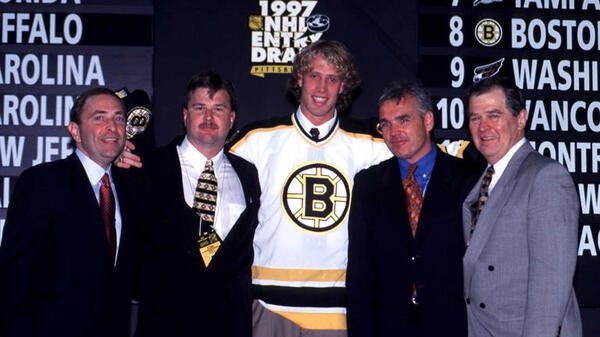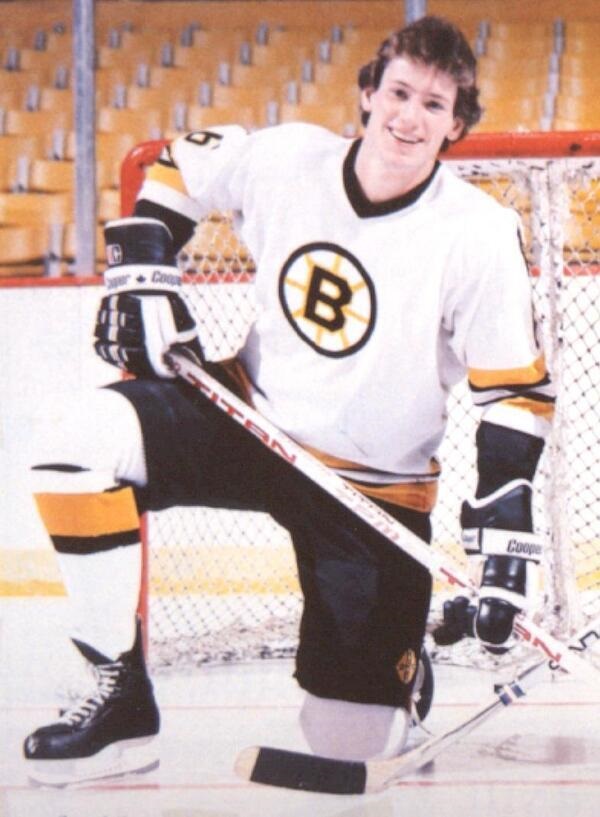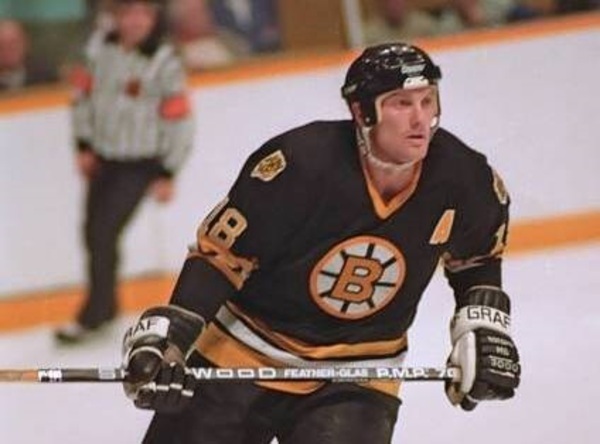
By: Steve McClure | Follow me on Twitter / X @stmcclure1993
Sometimes the NHL draft can be hit or miss enterprise. Despite all of the personnel scouting and calibrating of player potential and organizational needs, no team is immune from a complete miscarriage of an entire draft year, where none of the selections ever see more than a cup of coffee in the NHL.
Draft years which bear no NHL fruit—and even worse, back to back years—can cause long term damage to NHL clubs. For example, Bruins’ fans can be forgiven for forgetting the class of 2007—featuring such hockey luminaries as Zach Hamill, Tommy Cross, Denis Reul, Alain Goulet, Radim Ostrcil, and Jordan Knackstedt. That draft class only experienced a combined total of 23 NHL games.
With the NHL draft looming this weekend, it might be an amusing endeavor in recollecting the deepest Bruins’ draft classes of the past. A fair number of Bruins’ draft classes were, indeed, quite impressive.
1982 and 1997 had Bruins fans dreaming of glory, as Boston owned the first overall pick in each of those drafts. However, neither pick yielded the results Boston hoped for.

Defenseman Gord Kluzak, Boston’s pick in 1982, suffered significant knee injuries and—for all intents and purposes—managed only four full seasons before retiring at the age of 27. Joe Thornton, the golden boy center of the 1997 draft, was supposed to bring the Stanley Cup back to Boston. ‘Jumbo Joe’ did not live up to early expectations and was jettisoned by general manager Mike O’Connell—prematurely, as it turned out—to San Jose in 2005, where he would win the Hart Trophy as league MVP that very season and continue to thrive in a far less pressure-filled environment.
Though Thornton was not able to lead the Sharks to a title over the course of his career, he will most certainly be inducted into the NHL Hall of Fame next year for his offensive production.
Unfortunately, neither of the aforementioned drafts meted out the high return the number one overall selection can potentially produce. However, both drafts netted players that the Bruins developed and, as a result, received significant playing time in return. Besides Thornton, 1997’s draft also included Sergei Samsonov at the number eight position overall. No other Boston picks from that draft ever played an NHL game for Boston, but Thornton (532) and Samsonov (514) played 1,046 regular season games for the organization before moving on. The 1982 class included Kluzak (199 games) along with Lyndon Byers (261), Dave Reid (387), and Bob Sweeney (382)—a group that would suit up to play 1,329 regular season games for the Bruins. Successful draft years, for sure.
But let’s now take a look at perhaps the most productive draft years in Boston Bruins history. I’ve ranked the top three.
DRAFT CLASS of 1980
1980’s draft selections resulted in the third most man-power games the Bruins have received in a draft over the last 45 years. That particular draft class—three-centers-deep for Boston—played a total of 1,414 regular season games. Center Barry Pederson, the eighteenth pick overall, played 379 games in a Boston uniform, center Tom Fergus—the 60th pick overall — played 289, and Steve Kasper—chosen at 81st overall—played 564 NHL games for the Bruins. In addition, the Bruins managed another 182 regular season games out of defenseman Randy Hillier, the 102nd selection of the draft, and goaltender Mike Moffat, who was plucked at 165.
Pederson and Kasper would both emerge as varsity centers for head coach Gerry Cheevers’ club over the next few years. Pederson became a top-line threat centering Rick Middleton, and Kasper found success as a top-notch checking line center, winning the Selke Trophy in 1982. Both players were central to the Bruins’ success for the first half of the 1980s decade.
By the 1982-83 season, Fergus, too, earned plenty of playing time. He managed three straight 20-goal seasons, including 30 in 1984-85, before being jettisoned to Toronto for Bill Derlago—one of the weakest trades Harry Sinden ever made as GM.
In more of a minor way, Hillier and Moffat were offered opportunities as well. Hillier played two full years as a third-pairing defenseman for the Bruins before being traded to Pittsburgh for a fourth-round pick in 1984. Moffat made a memorable playoff run in 1981-82, after only making two regular season appearances. The nineteen-year-old bested Buffalo in the opening best-of-five series and then lost in seven games to an upstart Quebec Nordique team, led by Michel Goulet, Dale Hunter, and the Brothers Stastny. Moffat did not have staying power, however, and played only 16 more games for Boston.
None of the class of 1980 won titles in Boston, but Hillier did win a Stanley Cup with the Penguins. Pederson, of course, would be the key piece in a Sinden trade which landed legend-to-be right-winger Cam Neely as well as Vancouver’s 1987 first round pick—which turned out to be defenseman Glen Wesley. Kasper would later serve a short stint as Boston’s head coach for two seasons.
DRAFT CLASS of 2006
The draft class of 2006 helped prime the Bruins for a Stanley Cup five years later. Phil Kessel was chosen number five overall, Milan Lucic was picked at number 50, and Brad Marchand was chosen at number 71. Between the three of them, they played—to this date—1,821 regular season games for Boston.
Kessel showed great offensive potential early on but faltered to a degree under head coach Claude Julien’s system. He was traded to Toronto for their first round pick in 2010 (Tyler Seguin) and 2011 (Dougie Hamilton) as well as a 2010 second round pick (Jared Knight). Seguin, the talented forward, would be a part of the Bruins’ 2011 Stanley Cup winning-team.
The other two picks, Lucic and Marchand, would also play substantial roles on the 2011 championship team. By 2011 Lucic had become a dominant first-line power forward and Marchand, who had commenced the 2011 season as the team’s fourth-line left-winger, improved nightly and eventually played a vital role on a line with Mark Recchi and center Patrice Bergeron.
Lucic played eight full seasons with Boston before being traded to Los Angeles for their first round pick in 2015 (Jakub Zboril). After brief stints with the Kings, Oilers, and Flames, he returned to Boston in 2023 for four games before an injury and then, a short time later, assault charges derailed his return.
Marchand is still playing in what many people consider to be a potentially Hall-of-Fame-worthy career. He has played 1,029 regular season games for the Bruins, scoring 401 goals and producing a whopping 929 points in that time. He continues to climb toward the leader board in many Bruins statistical categories. He was named captain of the team last year after Bergeron’s retirement.
The draft class of 2006 resulted in a 2011 Stanley Cup for Lucic and Marchand. Kessel, for his part, would go on to win two Cups while playing for Pittsburgh and one more Cup as a member of the Vegas Golden Knights.
DRAFT CLASS of 1979
After signing as a free agent project from the WHA and posting a very solid 1977–78 season with the Boston Bruins, goaltender Ron Grahame was traded to the Los Angeles Kings for their first round pick in 1979. When the Bruins’ targeted choice, defenseman Keith Brown, was swiped one election ahead of the Bruins, Boston ‘settled for’ defenseman Raymond Bourque. In the years to come, Bruins’ fans would be treated to Bourque’s 1,518 regular season performances, 1,111 assists, and 1,506 points—all Boston Bruin records. The Hall-of-Fame blue liner collected five Norris Trophies while playing in Boston, second only to Bobby Orr’s eight.
Bourque was the eighth overall pick. Seven selections later, at number 15, Boston chose another defenseman named Brad McCrimmon. McCrimmon, like Bourque, made the Bruins roster immediately. The rugged defender played three full seasons with Boston before he was shipped to Philadelphia in June of 1982, as the Bruins were in search of a goaltending upgrade. Peter Peeters was the big return, and he immediately won the Vezina Trophy that initial 1982-83 season.
Pick 57 of that draft was Keith Crowder, a hard-nosed right-winger who put up six straight 20-goal seasons in Boston. In three of those seasons, he tallied 35, 32, and 38 goals. A top-six forward, Crowder played 607 career regular season games in Boston. He was an effective corner man and was not afraid to do the dirty work it takes to score in the goalmouth. Alongside fellow 1979 draft pick Bourque, Crowder helped the team reach the 1988 Stanley Cup finals.

Larry Melnyk was a defenseman chosen at 78 overall. He played 75 total games for Boston over the course of three seasons. Melnyk was a good shot blocker and a somewhat reliable stay at home third-pairing defender, but he couldn’t catch full time work in Boston. He was traded to Edmonton in a swap of defenseman, which landed the Bruins John Blum. Blum, too, played a minor role as the team’s depth blue liner on the 1988 squad.
At number 99 in that draft, Boston nailed down a net-minder by the name of Marco Baron. After years of stability with Gerry Cheevers and Gillis Gilbert protecting the Bruins’ net, from 1980-81 through 1981-82, Boston experienced a carousel of interested parties, including Jim Craig, Rogie Vachon, Moffat, and Baron. None of them were able to stabilize things, thus Sinden had to finally seek out Pete Peeters. Baron made 64 career appearances for the Bruins but was cast off to the Kings at the midpoint of the 1983-84 season while only seeing time in the AHL.
Forward Mike Krushelnyski, chosen way down at number 120 in the draft, found success riding shotgun on the Barry Pederson/Rick Middleton line, twice scoring 20 plus goals. After 162 games in Boston, he was exchanged for Ken Linseman in a deal with Edmonton in 1984. The move benefited both clubs, and ‘Krush’ had a tremendous season the following year, as the change in scenery resulted in a career high 43-45-88 line of production. Linseman, the play making center, became a key cog in the Bruins’ mid-to-late ‘80s success.
All told, the Bruins class of 1979 played a grand total of 2,654 regular season tilts (thank you, Mr. Bourque) for the organization. It’s easy to see that any NHL club that can strike it rich with a deep draft like this one, or the others referenced, can build and sustain a strong team for years on end. Oh, what the 2015 draft could have been, Bruins’ fans!
***As an interesting side light to that Bruins draft class of 1979, though none of the players won a championship while playing in a Bruins uniform, some of those players won the Stanley Cup with other teams. Ray Bourque finally won his only Stanley Cup with the Colorado Avalanche, Brad McCrimmon won a Stanley Cup with the Calgary Flames, Larry Melnyk won two Stanley Cup titles with the Pittsburgh Penguins, and Mike Krushelnyski won, altogether, four Stanley Cups— three with the Edmonton Oilers and one, as an assistant coach, with the Detroit Red Wings.


Leave a Reply